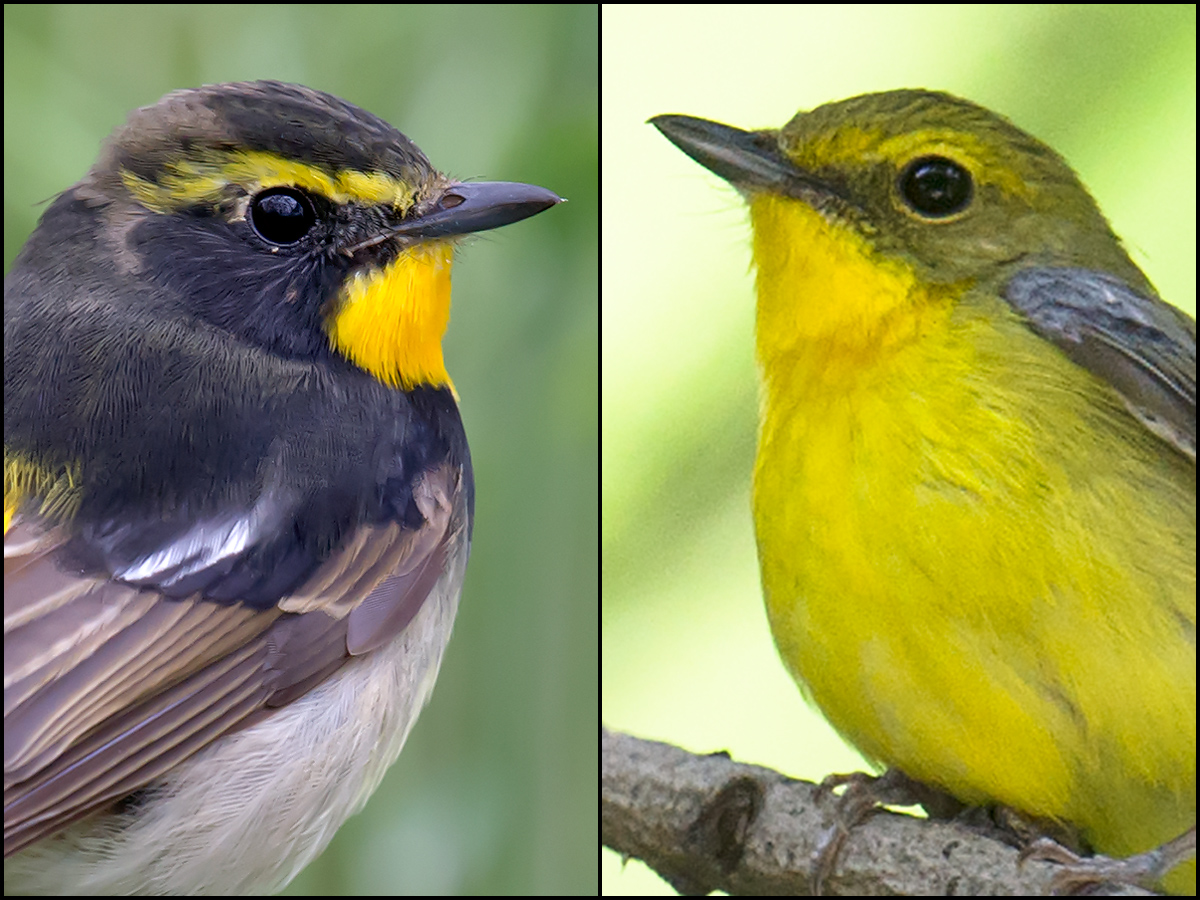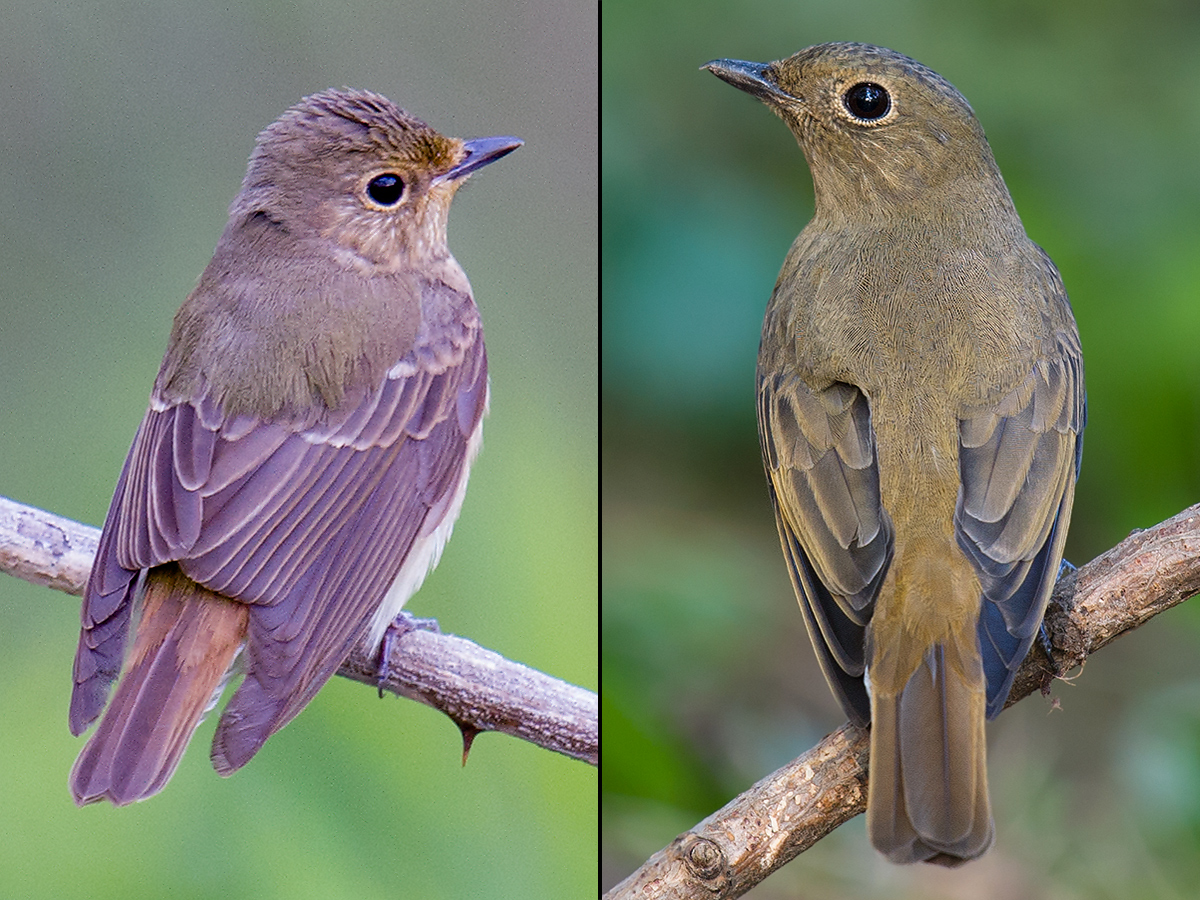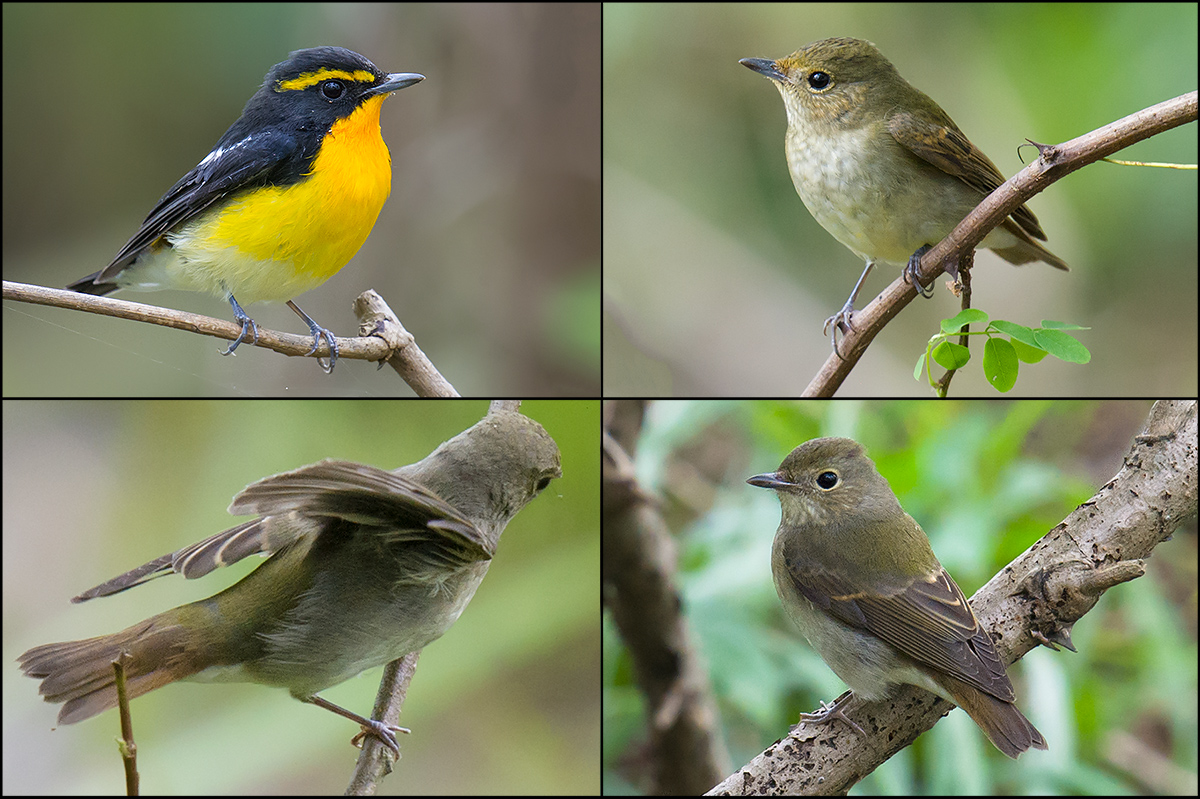by Craig Brelsford
Founder, shanghaibirding.com
Does Green-backed Flycatcher Ficedula elisae migrate through Shanghai? Records exist of the species, but in my opinion they are mainly misidentifications of female Narcissus Flycatcher F. narcissina narcissina (above). In this post, I am going to unearth the roots of my skepticism about F. elisae in Shanghai and describe the differences between female F. elisae and female F. n. narcissina.

Each spring and autumn, birders in Earth’s Greatest City claim records of elisae. Invariably, the bird in question is a female, not the very distinctive adult male. Here our first red flag pops up: How likely is it that elisae is the one species of passerine whose records in Shanghai never involve adult males?
For the sake of argument, let us admit the possibility of an all-female migration of elisae through Shanghai. Fine, I retort; then show me photos of these purported elisae. The photos are duly supplied, and again and again, as has been the case throughout my more than 10 years in Shanghai, the supposed F. elisae is revealed on closer scrutiny to be female F. n. narcissina.
Indeed, I have seen better documentation in Shanghai of Ryukyu Flycatcher F. (narcissina) owstoni than of F. elisae; in April 2016 at Pudong’s Binjiang Forest Park, Shanghai birder Zhang Xiaolei got a very interesting picture of a possible adult-male owstoni.
Mistakes of the sort many Shanghai birders are making contribute to a distorted picture of the presence on the central Chinese coast of a little-known species. What’s more, the mistakes are avoidable. Separation of female F. elisae and F. n. narcissina is usually straightforward.

Female F. elisae has greenish upperparts with a yellowish or olive tint. Female F. n. narcissina is greenish with a brownish tint, like female Blue-and-white Flycatcher Cyanoptila cyanomelana (above). On their underparts, female F. elisae is “dull yellow or yellowish-buff,” while F. n. narcissina is mainly off-white, with brownish-white flanks and a hint of yellow on the throat and belly (Brazil 2009, 436).
We can say, therefore, that unlike Pale-legged Leaf Warbler and Sakhalin Leaf Warbler, female F. elisae and F. n. narcissina are distinguishable by plumage. A good look or good photo will likely lead to an accurate ID.
Accurate records in Shanghai, one of the most thoroughly birded areas on the Chinese coast, will lead to better understandings of both F. elisae and F. n. narcissina. Already, the growing body of knowledge about these East Asian breeding endemics has led to the separation of F. elisae and F. n. narcissina into separate species. Previously, elisae had been treated as a subspecies of Narcissus Flycatcher.

We know as well that the summer and winter ranges of the sister species are disjunct, with F. elisae breeding in a very compact range in Hebei (Wulingshan), Beijing, and Shanxi and wintering in southern Thailand and Peninsular Malaysia. The breeding range of F. n. narcissina includes the main islands of Japan as well as the Kuril Islands, Sakhalin, and the coastal Russian Far East. The species winters in Hainan, the Philippines, and Borneo and passes through Shanghai each spring from about 15 April to 15 May.
Unlike other passage-migrant flycatchers in Shanghai, F. n. narcissina is much less common in autumn than in spring. That is a mystery, one of many surrounding the migration of the Narcissus Flycatcher group.
In light of the information deficit, it behooves us Shanghai birders to strive for accurate records (or non-records) of elisae in our region. Let us practice self-discipline, hone our skills, and give outside observers the clearest possible picture of bird migration in Shanghai.
BIBLIOGRAPHY
Brazil, Mark. 2009. Birds of East Asia. Princeton, New Jersey: Princeton University Press. Entries for Narcissus Flycatcher and Chinese Flycatcher (Ficedula elisae), p. 436.
Featured image: Adult female Narcissus Flycatcher Ficedula narcissina narcissina, Jiangsu, May. (Craig Brelsford)


More great flycatcher information, Craig. Let’s hope the ever-growing birding community in Shanghai can provide more and more data to help clear up the occurrences or not of Green-backed Flycatcher. If the community, led by you, was able to discover the occurrence of Sakhalin Leaf Warbler over Pale-legged Leaf Warblers, then hopefully it may do so again here.
In the meantime, I wonder if Zhongshan Park may turn up anymore interesting flycatchers in the middle of this huge city!
Hello Paul, thanks for your comment, and welcome to the Shanghai birding community. I believe Shanghai birders should up their birding game, because this city is one of the most important birding areas on the Chinese coast, and the world is depending on us for a clear picture of the birding situation here; I believe Shanghai birders can up their game, because social media loosens up the information flow, because more and more of us have cameras and recording devices, and because Web sites such as eBird allow us to keep ever-more accurate records; and I believe Shanghai birders will continue to up their game. A clearer picture of Green-backed Flycatcher, Sakhalin Leaf Warbler, and dozens of other tricky species will emerge through the efforts of the Shanghai birding community.
Hi Craig,
Thanks for another informative post. Here in Peninsular Malaysia we have just had our very first narcissina, and there have also been two in Singapore this season. I don’t disagree with any comments made regarding identification in your post, but I would just say that “female” types are likely to be much more common than adult males in autumn, since first years of both sexes look like females. Secondly, the female (or 1st cy male) Narcissus in Peninsular Malaysia shares its feeding territory with a male Green-backed. The male is territorially aggressive and always chases the Narcissus away, but I mention it because a male and female together at the same site need not necessarily be of the same taxa, at least away from the breeding grounds.
Hi Craig,
Not Shanghai, but I’ve just come across this undoubted Green-backed Flycatcher in Guangdong: https://macaulaylibrary.org/asset/58682991#_ga=2.249850181.218161508.1520229992-871282437.1500686190
Hi Dave—Great followup. Yes, that’s a Green-backed in Guangdong, all right. Thanks.
I reviewed this informative post again and checked the photo of male Green-backed Flycatcher and found the link of female Green-backed Flycatcher where we can have a look at the photos. Thanks Craig, for this post written by you in 2017, we will keep an eye on occurrences of this “special” species in Shanghai.